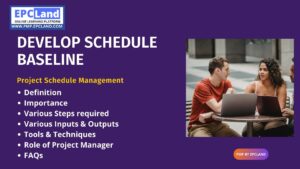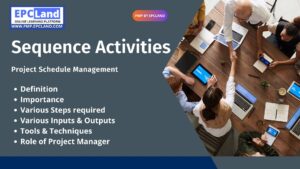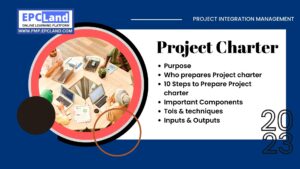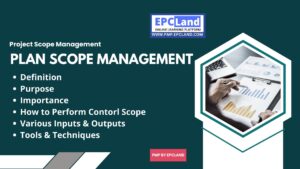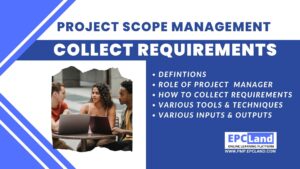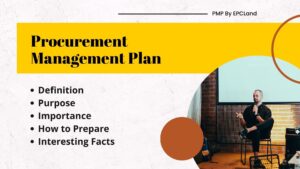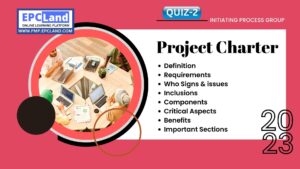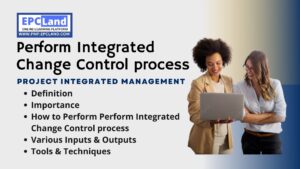Table of Contents
ToggleWhat is Control Scope in Project Scope Management
In project management, control scope refers to the process of monitoring and managing the project’s scope to ensure that it stays aligned with the project’s objectives and goals. The control scope process includes several activities such as, verifying the scope, controlling changes, monitoring the project’s performance, and taking corrective actions as necessary to keep the project on track.
It includes the following specific tasks:
- Identifying and documenting all of the work that needs to be done to complete the project.
- Reviewing and approving the project’s scope to ensure that it is accurate and complete.
- Monitoring and managing the project’s scope throughout the project’s lifecycle to ensure that it stays on track and that any changes are properly managed.
- Finalizing the project’s scope and obtaining formal acceptance from the stakeholders.
Control scope is an essential process in project management, it helps to ensure that the project stays on track, that resources are allocated effectively, and that stakeholders’ needs and expectations are met. It is a continuous process that starts from the planning phase and continues throughout the project’s life cycle, till the project is closed.
Attepmt Quiz-1 on Control Scope Process

Time's up
What are the various activities in Control Scope in Project Scope Management
The control scope process includes several activities, such as:
- Defining the project’s scope: This includes identifying and documenting all of the work that needs to be done in order to complete the project.
- Creating a work breakdown structure (WBS): This is a hierarchical representation of the project’s scope that breaks down the project into smaller, manageable tasks.
- Verifying the scope: This includes reviewing and approving the project’s scope to ensure that it is accurate and complete.
- Controlling the scope: This includes monitoring and managing the project’s scope throughout the project’s lifecycle to ensure that it stays on track and that any changes are properly managed.
- Closing the project: This includes finalizing the project’s scope and obtaining formal acceptance from the stakeholders.
The control scope process is an essential part of the project management process as it helps to ensure that the project stays on track and that the project’s objectives are met.
Don’t Miss the 1000+ MCQ questions & hundreds of quizzes on PMP Knowledge Areas and Various important sections.
Who is responsible in Control Scope in Project Scope Management
In project management, the project manager is typically responsible for controlling the scope of the project.
The project manager is responsible for:
- Defining the project’s scope and creating a work breakdown structure (WBS)
- Verifying the scope and ensuring that it is accurate and complete
- Controlling changes to the project’s scope, including managing and approving any change requests
- Monitoring the project’s performance and taking corrective actions as necessary to keep the project on track
- Finalizing the project’s scope and obtaining formal acceptance from the stakeholders
However, it is important to note that controlling the scope of a project is a team effort, and all team members have a responsibility to ensure that the project stays on track. Team members should be aware of the project’s scope and should inform the project manager of any potential scope changes. The stakeholders also play a critical role in the control scope process by providing feedback and approval of the project’s scope.
Ultimately, the project manager is accountable for controlling the scope of the project, but it requires the collaboration and cooperation of the entire project team and stakeholders to be successful.
How Control Scope is performed in Project Scope Management
Control scope in project scope management is typically performed through a series of steps, including:
- Defining the project’s scope: This includes identifying and documenting all of the work that needs to be done in order to complete the project. This includes creating a work breakdown structure (WBS) which is a hierarchical representation of the project’s scope that breaks down the project into smaller, manageable tasks.
- Verifying the scope: This includes reviewing and approving the project’s scope to ensure that it is accurate and complete. This step is critical to ensure that the project’s objectives and goals are clearly defined and understood by all stakeholders.
- Managing changes to the scope: This includes monitoring and managing any changes to the project’s scope throughout the project’s lifecycle. Changes to the scope can include both additions and deletions of work. This step involves managing and approving any change requests, and ensuring that the changes are properly integrated into the project plan.
- Monitoring the project’s performance: This includes monitoring the project’s progress and performance in relation to the project’s scope. Project managers use performance metrics such as cost, schedule, and quality to track the project’s progress and take corrective actions as necessary.
- Closing the project: This includes finalizing the project’s scope and obtaining formal acceptance from the stakeholders. This step is critical to ensure that the project’s objectives have been met and that the project is completed successfully.
Overall, control scope in project management is a continuous process that starts from the planning phase and continues throughout the project’s life cycle, until the project is closed. It requires the collaboration and cooperation of the entire project team and stakeholders to be successful.
Various Tools & techniques for Control Scope in Project Scope Management
There are several tools and techniques that can be used to control scope in project scope management. Some of the most common include:
- Work Breakdown Structure (WBS): A WBS is a hierarchical representation of the project’s scope that breaks down the project into smaller, manageable tasks. It is a useful tool for defining and organizing the project’s scope and for monitoring and controlling changes to the scope.
- Change Control: Change control is a process for managing and approving changes to the project’s scope. This can include changes to the project’s objectives, deliverables, or schedule. Change control is an important tool for ensuring that changes to the project’s scope are properly managed and integrated into the project plan.
- Scope Baseline: A scope baseline is a detailed document that defines the project’s scope, including the project’s objectives, deliverables, and milestones. The scope baseline is used as a point of reference for monitoring and controlling the project’s scope throughout the project’s lifecycle.
- Performance Reviews: Performance reviews are a technique for monitoring the project’s progress and performance in relation to the project’s scope. This can include reviewing the project’s schedule, cost, and quality metrics and taking corrective actions as necessary.
- Variance Analysis: Variance analysis is a technique for comparing the project’s actual performance to the project’s scope baseline. This can include analyzing the project’s schedule, cost, and quality metrics and identifying variances or deviations from the project’s scope.
- Project Management Software: various software like MS Project, Trello, Asana etc, can be used to control scope by helping to plan, organize, and track the project’s scope, schedule, and resources. These tools can also be used to monitor the project’s progress and performance and to generate reports.
It’s important to note that the appropriate tools and techniques will vary depending on the project’s size and complexity, and the needs and preferences of the project team and stakeholders.
What are inputs & Outputs in Conrol Scope process in Project Scope Management
It’s important to note that the appropriate tools and techniques will vary depending on the project’s size and complexity, and the needs and preferences of the project team and stakeholders.
What are inputs & Outputs in Conrol Scope process in Project Scope Management
The control scope process in project scope management has several inputs and outputs:
Inputs in Control Scope Process
- Project charter: The project charter is a document that outlines the project’s objectives, deliverables, and stakeholders. It serves as a foundation for the project’s scope and is used to establish the project’s scope baseline.
- Work breakdown structure (WBS): The WBS is a hierarchical representation of the project’s scope that breaks down the project into smaller, manageable tasks. It is used to define and organize the project’s scope and to monitor and control changes to the scope.
- Change requests: Change requests are requests for changes to the project’s scope. These can include changes to the project’s objectives, deliverables, or schedule.
- Performance reports: Performance reports are used to monitor the project’s progress and performance in relation to the project’s scope. These can include reports on the project’s schedule, cost, and quality metrics.
Attepmt Quiz-2 on Control Scope Process

Time's up
Outputs in Control Scope Process
- Updated project charter: The project charter is updated to reflect any changes to the project’s scope.
- Updated WBS: The WBS is updated to reflect any changes to the project’s scope.
- Approved or rejected change requests: Change requests are either approved or rejected based on their impact on the project’s scope.
- Corrective actions: Corrective actions are taken to address any variances or deviations from the project’s scope.
- Formal acceptance: The project’s scope is formally accepted by the stakeholders, indicating that the project’s objectives have been met and that the project is completed successfully.
- Final project report: A report is created with the final project results, the final deliverable and the results of the final acceptance by the stakeholders.
It’s important to note that the specific inputs and outputs may vary depending on the project’s size and complexity, and the needs and preferences of the project team and stakeholders.
FAQs on “Control Scope" in Project Scope Management
What is Control Scope in Project Management?
Answer: Control Scope is the process of monitoring the status of the project and managing changes to the project scope. This process involves comparing actual results with planned results, and taking corrective action when necessary to ensure that the project remains within the defined scope.
What are the key steps in the Control Scope process?
Answer: The key steps in the Control Scope process are:
- Monitor and control the project scope
- Validate and control the deliverables
- Control changes to the project scope
- Manage the project scope baselines
What is the purpose of the Control Scope process?
Answer: The purpose of the Control Scope process is to ensure that the project remains within the defined scope and that the project deliverables meet the project requirements and stakeholders’ expectations.
How do you manage changes to the project scope?
Answer: Changes to the project scope are managed through a formal change control process, which includes the following steps:
- Identifying the change
- Assessing the impact of the change
- Approving or rejecting the change
- Implementing the approved change
- Documenting the change
What are the benefits of Control Scope in Project Management?
Answer: The benefits of Control Scope in Project Management are:
- Ensures that the project stays within the defined scope
- Helps to control the project budget and schedule
- Improves the quality of project deliverables
- Increases stakeholder satisfaction by ensuring that their expectations are met.
Similar Articles in Project Scope Management
Add Your Heading Text Here
Lorem ipsum dolor sit amet, consectetur adipiscing elit. Ut elit tellus, luctus nec ullamcorper mattis, pulvinar dapibus leo.
Add Your Heading Text Here
Lorem ipsum dolor sit amet, consectetur adipiscing elit. Ut elit tellus, luctus nec ullamcorper mattis, pulvinar dapibus leo.
Add Your Heading Text Here
Lorem ipsum dolor sit amet, consectetur adipiscing elit. Ut elit tellus, luctus nec ullamcorper mattis, pulvinar dapibus leo.

